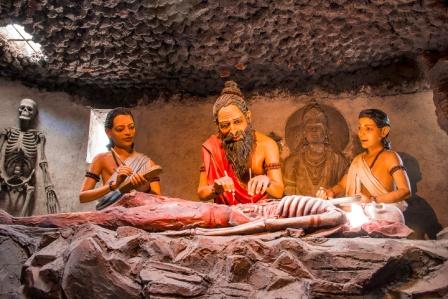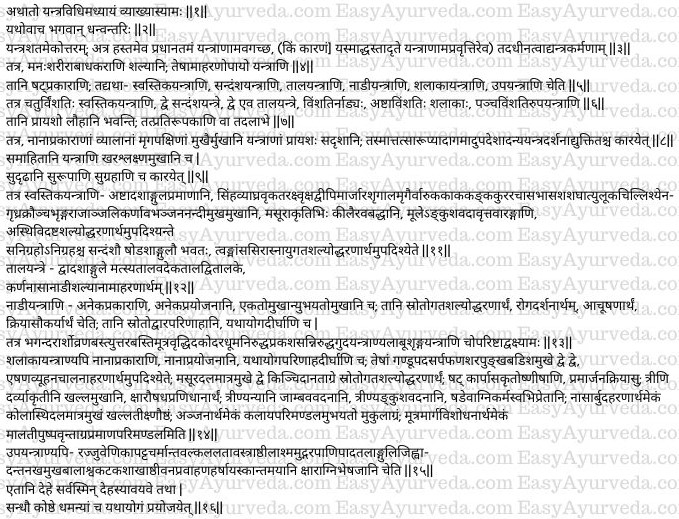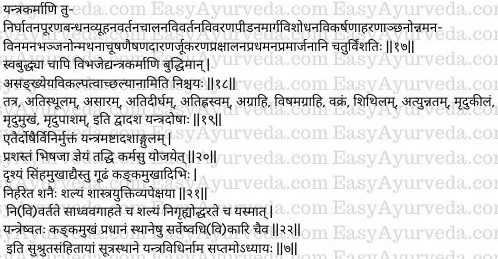Sushruta Samhita Chapter 7 Yantra Vidhi Adhyaya
This article explains Sushruta Samhita Sutrasthana Chapter 7 “Yantra Vidhi Adhyaya”- Blunt instruments and their usage.

Table of Contents
Yantra Vidhi Adhyaya
Blunt instruments and their usage
We will now expound the chapter by name, Yantravidi- usage of blunt instruments; as revealed by the venerable Dhanvantari.
Hand, the best yantra – blunt instrument
Yantras (blunt instruments) are one hundred and one in number. Among these blunt instruments, the hand itself is the most important one, please understand this. What is the reason? Hand is the best blunt instrument because without the hand the instruments cannot be used at all (we need hands to operate each and every instrument). All the functions of the instruments are dependent on it (hand).
Read – Yantra Instruments used in Ayurveda: Ashtanga Hrudayam Sutrasthana 25
Definition of Shalya
Those which cause trouble (pain) to the body and mind are known as shalya. The methods and instruments beneficial to remove (extract) these shalyas (foreign bodies) are known as yantras.
Yantra Bheda – Sankhya
Kinds and number of blunt instruments:
Yantras – blunt instruments are of six kinds based on their shapes
- Svastika Yantra – cruciform instruments
- Samdamsa Yantra – pincers, forceps etc) which bite or hold
- Tala Yantra – instruments with flat discs / scoops, spoon
- Nadi Yantra – tubular instruments / speculum
- Shalaka Yantra – rods, rod-like instruments / probes and
- Upad Yantra – accessory instruments
Numbers of each type of blunt instruments
- Svastika Yantra are twenty-four in number
- Samdamsa yantra are two in number
- Tala Yantra are two in number
- Nadi Yantras are twenty in number
- Salaka yantras are twenty-eight in number and
- Upayantras are twenty-five in number
Materials used for preparing instruments
The yantras are generally made of metals. In the absence or non-availability of the metals they are prepared with materials similar to the metals (substitute).
Read – Shastra – Surgical Instruments Of Ayurveda: Astang Hriday Sutrasthana 26
Face of instruments
The faces of these instruments generally resemble the shapes of the faces of various kinds of wild animals, tame animals and birds. This is because the faces / mouths of these animals and birds probably resemble the face or structures of the instruments.
Hence these instruments shall be prepared
- by keeping in mind, the resemblance in shape (of animals and birds),
- as per the advice found in the scriptures / treatises of medical science (so as to how to prepare the instruments),
- as per the advice of experts,
- by observing other kinds of instruments (as prepared in ancient times) and
- as per mode of usage / requirement (customized)
Read – Sushruta’s 8 Types Of Surgical Procedures – Astavidha Shastra Karma
Qualities of instruments
These instruments should be prepared, so as to conform to their size and shape. The faces of these instruments shall be hard, smooth, strong, good looking and easy to handle and with good grip.

- Svastika Yantras – cruciform instruments
Svastika Yantras are eighteen Angula in length (36 cm). They would have the shape of the face of lion, tiger, wolf, hyena, bear, panther, cat, fox, deer, megairvaruka, jackal, crow, heron, osprey, blue jay, eagle, owl, cilli (kinds of kite), hawk, vulture, kraunca (pond heron), bhringaraja (shrike), anjalikarna (a kind of bird), avabhanjana (a kind of bird) and nandimukha (flamingo); fixed with a nail (screw) of the shape of a Masura (lentil), their varanga (handle) bent like a goad at their root; these are useful for extracting (pulling out) the foreign bodies lodged in the bones.
Notes:- Angula- the ancient measure is defined as the breadth of the middle bone (phalanx) or joint of the middle finger of an adult male of medium build. In terms of metric measure this will be 1.98 cm approximately.
Read – Methods Of Surgical Training Elaborated In Ayurveda
2. Samdamsa yantra – Pincers, forceps etc
Samdamsa Yantras are of two kinds viz, Sanigraha (with a catch / lock) and Anigraha (without a catch / lock), sixteen angula (32 cm) in length, useful for pulling out foreign bodies lodged in the skin, muscles, veins and ligaments.
3. Tala Yantra – instruments with flat disc at their front end
Tala Yantras are of 12 angulas (24 cm) in length. They are of two kinds –
- Eka tala – having one disc resembling the palate of the fish
- Dwi tala – having two discs resembling the palate of the fish
They are used for removing foreign bodies from the ear, nose and sinuses.
Read – Foreign Body Removal – Ashtanga Hrudaya Sutrasthana 28
4. Nadi Yantra – Tubular instruments
Nadi Yantras are of many kinds and many uses. Some have openings at one end only and some will have openings at both their ends.
These are useful for extracting foreign bodies from the srotas (channels, minute pore etc), to observe the abnormalities inside these channels, for sucking (vitiated fluids like blood, pus etc) and for convenience of (other) functions (surgical and medical activities).
The circumferences of these instruments are of the size of the channels. Their lengths are made as per need and convenience (for effective use).
Bhagandhara Yantra, Arso yantra, Vranyantra, Basti Yantra, Niruddhaprakasa Yantra, Sanniruddhaguda Yantra, Alabu yantra and Srnga Yantra will be described further on.
Note:- Bhagandara Yantra is the instrument used in fistula-in-ano (Curette scope, rectal speculum). Arso Yantra is anal speculum / procto-scope. Vrana Yantra is a metal spring used for washing ulcers (syringe and irrigator). Basti Yantra is a rectal enema bag, nozzle and tube. Uttarabasti Yantra – are urethral syringes used for giving enema through urethral or vaginal routes (rubber ball vaginal douche). Dakodara Yantra is a trocar and canula for draining ascites. Dhauma Yantra is a tube used for inhalation therapy (inhaler / respirator). Niruddhaprakasa Yantra is the instrument used for treating phimosis (prepuce or urethral dilator). Sanniruddha Guda Yantra is a rectal dilator / bougie used for treating constricted rectum. Alabu yantra is hollow pitcher ground useful for aspiration. Srnga Yantra is the horn of cow etc used for aspiration.
5. Shalaka Yantra – rod like instruments
Shalaka Yantras (rod-like instruments) are of many kinds and many uses. Their length and thickness are found suitable (for their function). Among them Gandupada mukha (those with their face similar to that of an earthworm – blunt probe), Sarpaphana mukha (having face of the shape of the hood of the snake – retractors), Sarapunkha mukha (face resembling the flower of sarpunkha) and badisa mukhav (face in the shape of a hook) are two each. They are useful for Esana (searching / probing), Vyuhana (collecting), Calana (shaking) and Aaharana (extracting / pulling); two with their face of the size (and shape) of a Masura dala (cotyledon of a lentil) slightly bent upward, useful for removing foreign bodies from srotas (channels), six Salaka (rods) fitted with cap made of cotton for use in cleaning acts, three in the shape of a ladle with face bent down, useful for the purpose of applying caustic alkali; another three resembling the fruit of Jambu (Eugenia jambolana Lam), three with their face shaped like Ankusa (elephant goad); six used for branding (thermal cautery), one used for pulling out (extraction) Nasa Arbuda (polyp or tumour inside the nose) with its face of the size of seed of Kola (fruit of Zizyphus jujuba Plank) with bent and sharp lips; one useful for applying collyrium to the eyes, round in shape with thickness of a Kalaya (round pea) its two ends being in the shape of a flower bud; one useful for cleaning / cleaning the urinary passage(urethra), round in shape of the thickness of lip (end) of the stalk of a Malati (jasmine) flower.
Notes:- Salaka Yantras are probes, dilators, scoops, swab sticks, rods for branding, applying collyrium, urethral sound, uterine sound etc.
6. Upa Yantras – accessory instruments
Rajju (rope), venika (plait / thread wound in three strings or knitted in three parts), putta (sheet of leather or cloth), Carma (leather), Antarvalkala (thin inner layer of bark of trees), Lata (creeper), Vastra (cloth), Asthilasma (hard stone), Mudgara (mortar), Panipada tala (palm and sole), anguli (fingers), Jihva (tongue), Danta (teeth), Nakha (Nails), Mukha (mouth), Vala (hairs), Avakataka (Horses bridle), Sakha (Branch of tree), shyvana (spittle, act of spitting), Pravahana (straining), Harsa (joy excitement), Ayaskanta (magnet), Ksara (caustic alkali), Agni (fire), bhesaja (medicine / drug etc).
These can be made use of all over the body, in all its parts, organs, joints, alimentary tract and arteries (blood vessels) as and how found useful.
Read – Shashti Upakrama Meaning, Classification, Clinical Significance

Yantra Karma
Functions of the instruments
Yantra karma (functions of blunt instruments) are twenty-four:- such as –
1. Nirghanta (shaking and then pulling)
2. Purana (filling)
3. Bandhana (tying, fixing)
4. Vyuhava (Collecting at one place)
5. Vartana (rolling)
6. Calana (moving, sliding, transferring, shifting)
7. Vivartana (rotating)
8. Vivarana (exposing, opening, dilating)
9. Pidana (squeezing, kneading)
10. Marga visodhana (cleaning the passage)
11. Vikarsana (splitting and then pulling)
12. Aharana (extracting, pulling out)
13. Anchana (pulling up to the surface, elevating, traction)
14. Unnamana (lifting up)
15. Vinamana (pushing down)
16. Bhanjana (bending, breaking)
17. Unmathana (making a churning movement)
18. Acusana (sucking, aspiration)
19. Esana (probing, searching)
20. Darana (bursting, cracking)
21. Rujukarana (straightening)
22. Praksalana (washing, bathing)
23. Pradhaman (blowing air, insufflation)
24. Pramarajana (sweeping, mopping, cleaning)
The foreign bodies are of innumerable kinds. Therefore, an intelligent physician may carry out the actions of the instruments, using his own intelligence (make choice of instruments as per convenience of usage in a given condition using his skill and intelligence).
Read – Rasashastra Yantra Prakarana (Science of Appliances)
Yantra Dosas
Defects of the Instruments
Defects of blunt instruments are twelve such as
1. Atisthula (very thick)
2. Asaram (without strength, soft)
3. Ati Dirgha (very long)
4. Ati hrsva (very short)
5. Agrahi (the physician cannot hold it properly i.e., does not come into hold / not holding the objects well)
6. Visama grahi (holding objects in an improper way)
7. Vakra (crooked, irregular, asymmetrical)
8. Sithila (soft weak)
9. Atyunnata (very elevated, with a prominent part)
10. Mrdukila (soft or loose nails, pins, rivets)
11. Mrdu Mukha (soft face / holding part)
12. Mrdu pasa (with soft / loose threads)
Read – Procedure of surgical operation: Ashtanga Hrudaya Sutrasthana 29
Ideal blunt instrument
The blunt instruments devoid of these (twelve) defects and of eighteen Angula (36cm) in length are to be judged as ideal and should be used in surgical activities.
Foreign bodies which are visible should be pulled out slowly by using instruments like Simhamukha (lion faced forceps) etc. Foreign bodies which are invisible should be pulled out slowly by using Kanka mukha (heron beak forceps) etc, in accordance with the directions of the text.
Among blunt instruments, Kanka mukha Yantra (heron -bill forceps) is the chief, since it comes out easily (can be withdrawn easily), gets inside easily (can be inserted inside easily), holds the foreign body firmly and so is the master (best for work) at all places of the body.
Thus ends the Seventh chapter by name Yantra Vidhi- In Sutra Sthana of Susruta Samhita.







